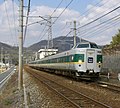381 series
| 381 series | |
|---|---|
 A 381 series on a Kounotori service in January 2013 | |
| In service | 1973–June 2024 (regular service) |
| Manufacturer | Hitachi, Kawasaki Heavy Industries, Kinki Sharyo |
| Replaced | 183 series |
| Constructed | 1973–1982 |
| Entered service | 1973 |
| Refurbished | 1997–2011 (JR West) |
| Number built | 277 vehicles |
| Number in service | None |
| Number preserved | 2 vehicles |
| Number scrapped | 140 vehicles |
| Successor | 383 series, 287 series, 289 series, 273 series |
| Formation | 3/4/6/7/9 cars per trainset |
| Operators | JNR (1973–1987) JR Central (1987–2008) JR West (1987–2024) |
| Depots | Hineno, Goto, Fukuchiyama |
| Lines served | Various |
| Specifications | |
| Car body construction | Aluminium alloy |
| Car length | 21,300 mm (69 ft 11 in) |
| Width | 2,920 mm (9 ft 7 in) |
| Height | 3,383 mm (11 ft 1.2 in) |
| Maximum speed | 120 km/h (75 mph) |
| Traction system | Resistor control |
| Electric system(s) | 1,500 V DC overhead lines |
| Current collector(s) | Pantograph |
| Track gauge | 1,067 mm (3 ft 6 in) |
The 381 series (381系, 381-kei) was a tilting DC electric multiple unit (EMU) train type introduced in 1973 by Japanese National Railways (JNR), and operated by West Japan Railway Company (JR West), and Central Japan Railway Company (JR Central) in Japan.[1]
History
[edit]
The 381 series EMU was developed from the experimental 591 series 3-car articulated tilting EMU tested from 1970.[2]
Trainsets entered revenue service from 10 July 1973 on the Shinano limited express between Nagoya and Nagano.[2]
JR-West 381 series trains were removed from Kuroshio, Kounotori, Kinosaki, and Hashidate limited express services in October 2015, with the last services operating on 30 October.[3]
As the new 273 series sets began service from 6 April 2024, it was announced by JR West in December 2023 that the remaining 381 series sets were scheduled to be retired from June 2024.[4] The next sets to be retired were those repainted in various historic liveries; the sets sporting the Yuttari Yakumo livery were scheduled for retirement at a later date.[5] The last regularly scheduled Yakumo run by this series took place on 15 June 2024 thus marking the end of regular service of the 381 series as a whole.[6]
Fleet
[edit]As of 1 April 2023[update], 62 vehicles were operated by JR-West.[7][unreliable source?]
Operations
[edit]JR Central
[edit]- Shinano (1973–May 2008)
JR West
[edit]- Kuroshio (from October 1978 until 30 October 2015[8])
- Yakumo (from July 1982 until 15 June 2024[6])
- Kounotori (until 31 May 2011,[9] from 1 June 2012[10] until 30 October 2015[3])
- Kinosaki (from 1 June 2012[10] until 30 October 2015[3])
- Hashidate (from 16 March 2013 until 30 October 2015[3])
- Hanwa Liner rapid service (until March 2011)
- Yamatoji Liner rapid service (until March 2011)
Livery variations
[edit]- JNR Livery (JR Central Shinano set), July 2006
- JR-West Kuroshio refurbished set
- 381 series Super Kuroshio set, 1992
- 381 series Super Kuroshio KuRo 380 refurbished car
- JR-West Yakumo set, July 2007
- JR-West set in Super Yakumo livery, September 2007
- JR-West set in Yuttari Yakumo livery, July 2023
Preserved examples
[edit]- KuHa 381-1: (built 1973 by Kawasaki Heavy Industries) SCMaglev and Railway Park, Nagoya.[11]
- KuRo 381-11: (built 1974 by Kawasaki Heavy Industries) formerly at the SCMaglev and Railway Park, Nagoya,[11] removed in June 2019.[12]
- KuRo 381-1104: (built 1978 by Kawasaki Heavy Industries) Suita Depot, Osaka.
- Preserved KuHa 381-1 at the SCMaglev and Railway Park, April 2011
- KuRo 381 at the SCMaglev and Railway Park, March 2016
- KuRo 381-1104 in May 2019
Notes
[edit]References
[edit]- ^ Jēāru zensharyō handobukku: Rail Magazine 2009 JR全車輌ハンドブック2009 [JR Rolling Stock Handbook 2009] (in Japanese). Japan: Neko Publishing. 2009. ISBN 978-4-7770-0836-0.
- ^ a b プロトタイプの世界 – Prototype World. Japan: Kōtsū Shimbunsha. December 2005. pp. 12–19. OCLC 170056962.
- ^ a b c d 381系が関西地区の定期運用から離脱 [381 series removed from scheduled Kansai area services]. Japan Railfan Magazine Online (in Japanese). Japan: Koyusha Co., Ltd. 31 October 2015. Retrieved 1 November 2015.
- ^ "381系「リバイバル塗装車両」6月までに運転を終了" [Remaining 381 series to be retired by June 2024]. Japan Railfan Magazine Online (in Japanese). 16 December 2023. Retrieved 19 December 2023.
- ^ "381 系特急やくも「リバイバル塗装車両」の今後の運行計画について" [Regarding the decommissioning of the 381 series limited express Yakumo sets featuring “revival liveries”] (PDF). westjr.co.jp (in Japanese). 15 December 2023. Retrieved 10 February 2024.
- ^ a b "「国鉄特急型電車」定期運用は終焉へ 381系約50年の生涯を振り返る!" [Regular service of the "Japanese National Railways Limited Express train" comes to an end - looking back at the 50-year life of the 381 series!]. RM News (in Japanese). Japan: Neko Publishing. 15 June 2024. Retrieved 16 June 2024.
- ^ "JNR 381 series - The Red List of Trains in Japan". bateman.monologue.jp. Retrieved 31 May 2023.
- ^ くろしお381系引退へ…パンダシートも見納め [Kuroshio 381 series to be withdrawn – Also end of panda seats]. Yomiuri Online (in Japanese). Japan: The Yomiuri Shimbun. 29 October 2015. Archived from the original on 24 October 2015. Retrieved 29 October 2015.
- ^ "新型車両(287 系)追加投入の詳細" [Details of further introduction of new (287 series) trains] (PDF). JR-West news release (in Japanese). West Japan Railway Company. 28 April 2011. Archived from the original (PDF) on 27 September 2011. Retrieved 2 May 2011.
- ^ a b "JR西日本 381系福知山車FE編成が営業運転開始" [JR-West: Fukichiyama-based 381 series FE sets enter service]. Tetsudō Daiya Jōhō Magazine. 41 (340): 75. August 2012.
- ^ a b "「リニア・鉄道館」ファーストガイド" ["SCMaglev and Railway Park" First Guide]. Tetsudō Daiya Jōhō Magazine. 40 (324): 20–33. April 2011.
- ^ リニア・鉄道館 N700系車両の展示について [N700 series shinkansen exhibit at SCMaglev and Railway Park] (PDF). News release (in Japanese). Japan: Central Japan Railway Company. 17 May 2019. Retrieved 14 July 2019.


 French
French Deutsch
Deutsch










